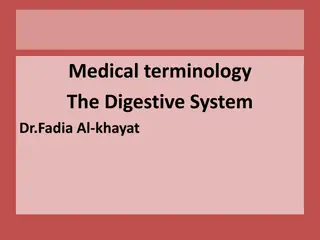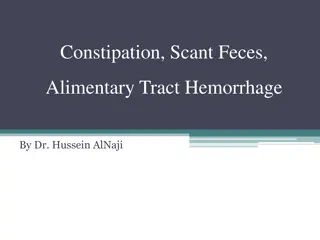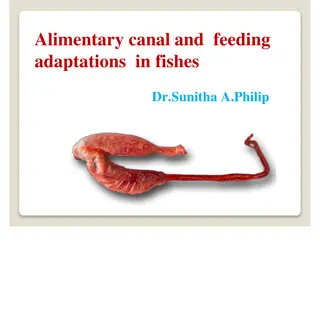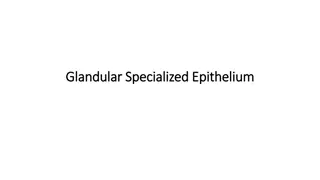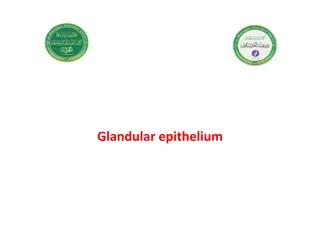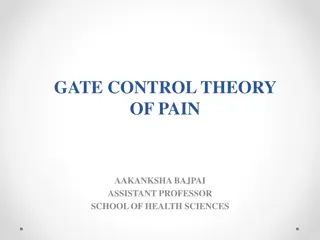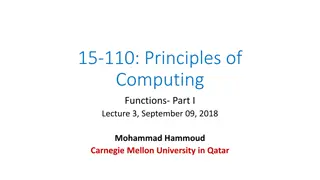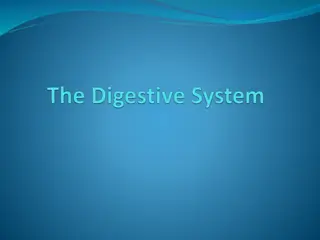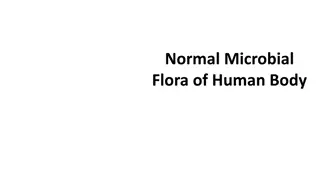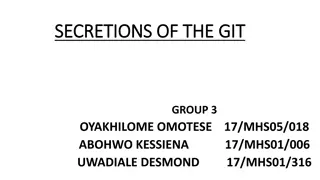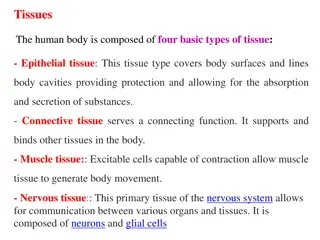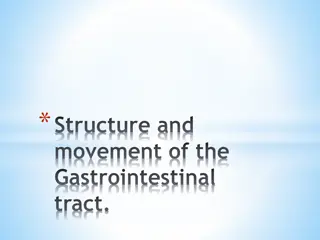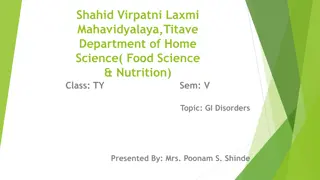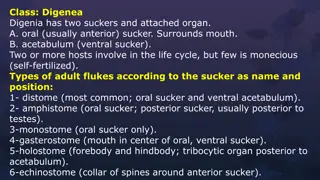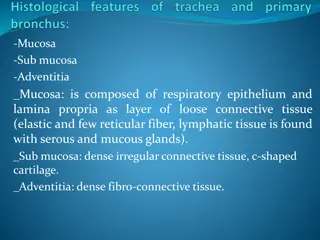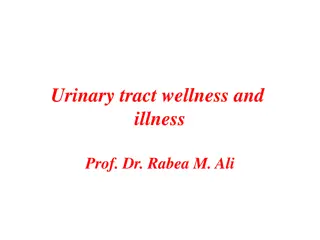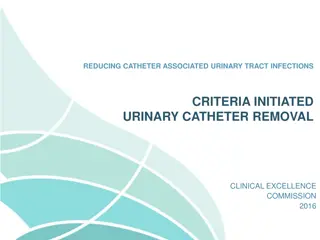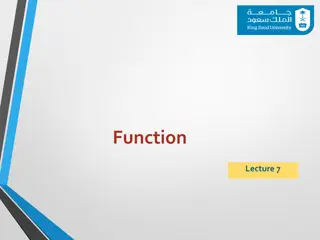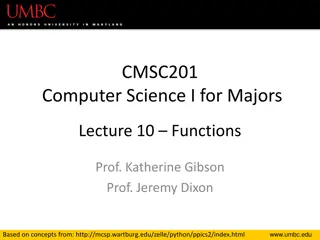Secretory Functions of the Alimentary Tract
This content delves into the secretory functions of the alimentary tract, focusing on the secretion of saliva and the role of mastication. It covers the anatomy of salivary glands, composition of saliva, control of secretion by the nervous system, and the functions of saliva in lubrication, protection, and digestion. The process of mastication, including teeth organization and chewing reflexes, is also explained. Additionally, it discusses the functions of secretory glands in providing digestive enzymes and mucus for lubrication and protection.
Download Presentation

Please find below an Image/Link to download the presentation.
The content on the website is provided AS IS for your information and personal use only. It may not be sold, licensed, or shared on other websites without obtaining consent from the author. Download presentation by click this link. If you encounter any issues during the download, it is possible that the publisher has removed the file from their server.
E N D
Presentation Transcript
Chapter 63; page: 763 Chapter 64; page 773-777 Secretory Functions of the Alimentary Tract (Secretion of Saliva) Mohammed Alzoghaibi, PhD Cell Phone #: 0506338400 zzoghaibi@gmail.com
Learning objectives Mastication and Chewing reflex The functions of secretory glands Anatomical types of glands Salivary glands Secretion of saliva and its characteristics Composition of saliva Lubricating and protective properties of mucus Secretory unit (salivon) Saliva and its flow rate Functions of saliva Control of secretion by sympathetic and parasympathetic nervous systems
Mastication (Chewing) Functions: 1. 2. 3. To lubricate the bolus with salivary secretion To breakdown the bolus to small particles To begin digestion of carbohydrate ( -amylase)
Mastication (Chewing) Teeth organization Anterior teeth (incisors) for cutting Posterior teeth (molars) for grinding Chewing muscles are innervated by CN-V (5th cranial nerve). Chewing process is controlled by nuclei in the brain stem. Masseter Temporalis Lateral Pterygoid Medial Pterygoid Taste centers in the brain stem and Hypothalamus) rhythmical chewing movements o Much of the chewing process is caused by a chewing reflex & stretch reflex
Mastication (Chewing) Chewing reflex & stretch reflex The presence of a bolus of food in the mouth at first initiates reflex inhibition of the muscles of mastication, which allows the lower jaw to drop. The drop in turn initiates a stretch reflex of the jaw muscles that leads to rebound contraction. This automatically raises the jaw to cause closure of the teeth, but it also compresses the bolus again against the linings of the mouth, which inhibits the jaw muscles once again, allowing the jaw to drop and rebound another time; this is repeated again and again.
Chapter 64; page 773 Secretory Functions of the Alimentary Tract The functions of Secretory Glands: 1. Secretion of digestive enzymes 2. Provide mucus for lubrication and protection Most digestive secretions are formed only in response to the presence of food in the alimentary tract, and the quantity secreted in each segment of the tract is almost exactly the amount needed for proper digestion.
Anatomical Types of Glands 1. Single-cell mucous glands (goblet cells), they produce mucus. 2. Crypts of Lieberk hn at the mucosal pits in small intestine (they represent invaginations of the epithelium into the submucosa). They release several digestive enzymes. 3. Tubular glands that include an acid and pepsinogen- secreting gland (in the stomach). 4. Salivary glands, pancreas, and liver. They are located outside the walls of GI tract. They contain millions of acini lined with secreting glandular cells; these acini feed into a system of ducts that finally empty into the alimentary tract itself.
Basic Mechanisms of Stimulation of the Alimentary Tract Glands Effect of Contact of Food with the Epithelium: Function of Enteric Nervous Stimuli: The mechanical presence of food in a particular segment of the GI tract usually causes the glands to secrete moderate to large quantities of juices. The types of stimuli that do this are: (1) tactile stimulation. (2) chemical irritation. (3) distention of the gut wall.
Basic Mechanisms of Stimulation of the Alimentary Tract Glands (cont.) Autonomic Stimulation of Secretion: 1. Parasympathetic Stimulation: Stimulation of the parasympathetic nerves to the alimentary tract almost increases the rates of GI secretion, especially in the upper portion of the tract: salivary glands, esophageal glands, gastric glands, pancreas, Brunner s glands in the duodenum and the distal portion of the large intestine. Secretion in the remainder of the small intestine and in the first two thirds of the large intestine occurs mainly in response to local neural and hormonal stimuli in each segment of the gut.
Basic Mechanisms of Stimulation of the Alimentary Tract Glands (cont.) Autonomic Stimulation of Secretion: 2. Sympathetic stimulation can have a dual effect: First, sympathetic stimulation alone usually slightly increases secretion. But, second, if parasympathetic or hormonal stimulation is already causing copious secretion by the glands, superimposed sympathetic stimulation usually reduces the secretion, sometimes significantly because of vasoconstrictive reduction of the blood supply.
Basic Mechanisms of Stimulation of the Alimentary Tract Glands (cont.) Regulation of Glandular Secretion by Hormones: In the stomach and intestine, several GI hormones help regulate the volume and character of the secretions. They are liberated from the GI mucosa in response to the presence of food in the lumen of the gut. The hormones then are absorbed into the blood and carried to the glands, where they stimulate secretion.
Basic Mechanism of Secretion by Glandular Cells The nutrient material needed for formation of the secretion must first diffuse or be actively transported by the blood in the capillaries into the base of the glandular cell. Mitochondria use oxidative energy to form ATP. Energy from the ATP, along with appropriate substrates provided by the nutrients, is then used to synthesize the organic secretory substances in the endoplasmic reticulum and Golgi complex. 4. In the Golgi complex, the materials are modified, added to, concentrated, and discharged into the cytoplasm in the form of secretory vesicles. 5. These vesicles remain stored until nervous or hormonal control signals cause the cells to extrude the vesicular contents through the cell s surface, exocytosis. 1. 2. 3.
Lubricating and Protective Properties of Mucus: Mucus is a thick secretion composed mainly of water, electrolytes, and glycoproteins The mucus is an excellent lubricant and a protectant for the wall of the gut because of the following: 1. It has adherent qualities that make it adhere tightly to the food. 2. It has sufficient body that it coats the wall of the gut and prevents actual contact of most food particles with the mucosa. 3. It has a low resistance for slippage. 4. It causes fecal particles to adhere to one another. 5. It is strongly resistant to digestion by the GI enzymes. 6. The glycoproteins of mucus have amphoteric properties, (buffering small amounts of either acids or alkalies).
SALIVARY GLANDS The principal glands of salivation are: 1. Parotid glands 2. Submandibular (Submaxillary) glands 3. Sublingual glands 4. Smaller glands in mucosa of tongue, palate, etc. Daily secretion of saliva = 800-1500 mL (average value of 1000 mL) with pH = 6-7
Secretion of Saliva and its Characteristics Saliva contains two major types of secretion: 1. Aqueous fluids (a serous secretion) Water, ions and enzymes such as ptyalin (an - amylase) Parotid, Submandibular and Sublingual glands 2. Mucus secretion (mucin) Submandibular and Sublingual glands
Composition of Saliva Aqueous Fluids o H2O, K, HCO3, Na, Cl, -amylase, lingual lipase, IgA, kallikrein, muramidase (lyses muramic acid of Staphylococcus), lactoferrin and epithelial growth factor (EGF) o Hypotonic Solution Ions Na, K, CI, HCO3: (the concentrations of these ions are altered with altered flow rates), e.g., at low flow rate (under resting condition): the salivary secretions have: i. High K (7 times as great as in plasma) and HCO3 (2-3 times that of plasma). ii. Low Na+ and Cl- (1/7 or 1/10 their concentrations in plasma)
Composition of Saliva (cont.) Enzymes i. -amylase (from parotid glands) cleaves -1 ,4-glycosidic bonds The optimal pH for this enzyme to work properly is 7 Inactivated at pH 4 but continues to work for sometime in unmixed food in Orad portion of stomach ii. Lingual lipase hydrolyzes lipids continues working in the duodenum iii. Kallikrein (a protease from acinar cells, which is not secreted into the salivary secretion): Catalyzes production of bradykinin (good vasodilator) from 2- globulin Bradykinin increases local blood flow Water (0.5 L saliva/day)
Secretory Unit (salivon) The basic unit salivon consists of: 1. Acinus -initial secretory process 2. Intercalated duct -initial portion of duct 3. Striated duct -modification of secretory product 4. Myoepithelial cells surround acinus and intercalated duct contraction moves saliva, prevents development of back pressure
Functions of Saliva Saliva helps prevent the deteriorative processes in the mouth in several ways: 1. It moistens food 2. It begins digestion 3. It adjusts salt appetite 4. The flow of saliva helps wash away pathogenic bacteria. 5. Saliva contains several factors that destroy bacteria such as thiocyanate ions, antibodies, lactoferrin which chelates iron necessary for bacterial growth and proteolytic enzymes such as lysozyme which is: i. active against bacterial walls ii. helps thiocyanate ions in entering bacterial wall where they become bactericidal.
Control of Secretion Unique aspect of control of salivary secretion secretion rate depends entirely on neural control autonomic nervous system (ANS) both Parasympathetic and Sympathetic lead to increase secretion Composition modified by Aldosterone: increases Na+ and Cl- reabsoption increases K+ secretion i. ii.
Parasympathetic The origins of parasympathetic neurons are: salivary nuclei in medulla and pons (brain stem). Outflow CN VII & IX Transmitter Ach It is stimulated in response to: conditioned reflexes (taste, smell, and tactile stimuli) Its stimulation is reduced due to sleep, fear, dehydration
Parasympathetic Stimulates - the secretion (protein poor, high k and HCO3) - the contraction of myoepithelial cell - the metabolic rate - the blood flow - the direct innervation of blood vessels - the growth and development of different cells Sectioning of parasympathetic markedly decreases flow & leads to atrophy
Sympathetic The origin of sympathetic nerves are: intermediolateral gray T1-T3 Transmitter norepinephrine Stimulates - secretion (mostly enzymes) - contraction of myoepithelial cell - metabolic rate - growth and development of different cells Sectioning of sympathetic nerves has minimal impact on secretion




